2. KNOW HOW THE PIECES MOVE
You set up the board. You're pumped and raring to go. You may have even taken a break to grab a cheese sandwich. But now it's time to buckle down and get serious: we're gonna talk about how each piece is allowed to move. Every piece has different rules about how it can move. But first, keep in mind that only one piece can ever be in a square at a time. So if you want to put your piece in a square that already has a piece in it, you have two options:- If the piece in the square is yours, you have to move it out of the way before you can occupy it.
- If the piece in the square is Moe's, then you can "capture" his piece. Don't say that you "killed" or "got" or "thrashed" Moe's piece. Moe's already in enough pain. Instead, be a classy chess player and say that you captured his piece. You then put your piece in the box on the board, take his piece off the board, and trimphantly place it next to you. That piece is now out of play forever.
So we will now provide you with the rules of how each piece can move: the rook, the bishop, the queen, the king, the knight, and the pawn.
The Rook
The rook is very easy: it only moves up and down, or side to side. It can't go diagonal or sideways or anything else except along a rank or file. It is not allowed to jump over any pieces. The chessboard below shows how a rook is allowed to move. This shows ONE move. If you want to move the rook from c4 to e6, you'd have to first move the rook from c4 to e4, and then on your next turn from e4 to e6. This goes for all pieces: whatever the piece's rule, it lasts one turn.
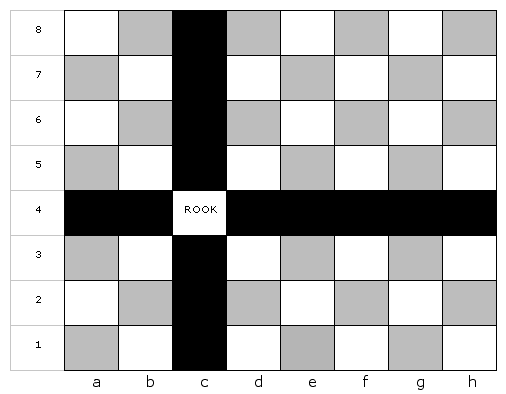
Well, actually, there is ONE time when the rook is allowed to jump over another piece. But don't worry about that sitchy-ashun until you get to the special moves section of this article.
The Bishop
The bishop can only move in a diagonal line for as many spaces as it likes until something blocks it. It also cannot jump over any other pieces during its move. Since bishops only move in diagonal lines, they'll always stay on the same color square that they started on (one starts on a black square, and one on a white). If at some point in the game, both your bishops are on white squares, somebody screwed up. The chessboard below shows how a bishop can move and groove.
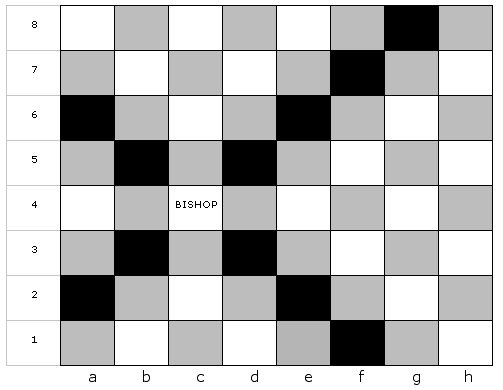
The Queen
The queen is a combination of the rook and the bishop: it can move as many spaces as it likes along a rank, file, or diagonal. Check out all of the ways a queen can move on the board below. That is one cool diva.
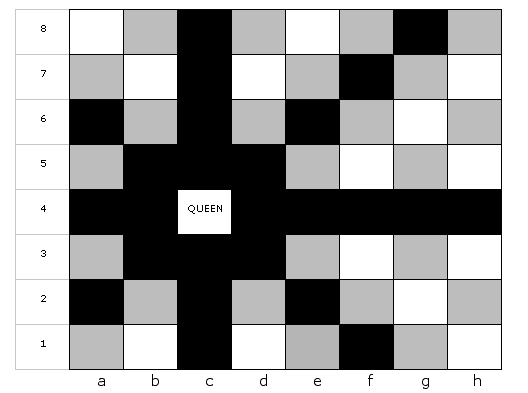
The King
The king is exactly like the queen, except for that like all husbands, he's not as powerful as his wife. He can move in any direction, but only for one box. An example would best explain this:
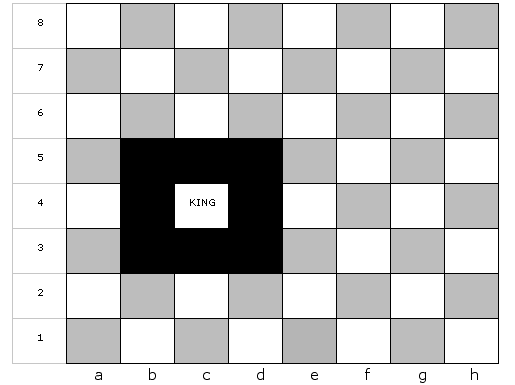
The Knight
OK, things get a little gooey now. The knight can only move in an L-shape. This means that it moves a total of three boxes: 2-straight 1-sideways, or 1-straight 2-sideways. This definitely needs an example. Or lots of liquor:
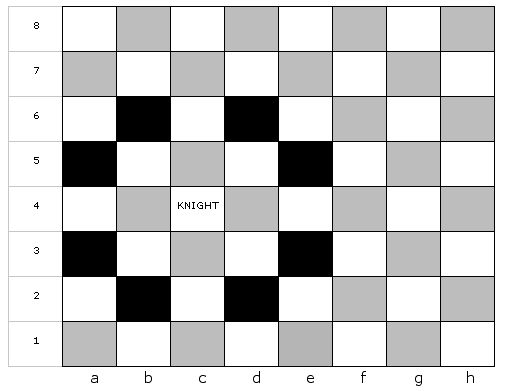
Note how for the knight to move to any one of these spaces, it must moves in an L. For instance, when the knight travels from c4 (where it lies above) to e3, it moves 2 right, 1 down. When it moves from c4 to d2, it moves 1 right, 2 down. It's a bit confusing at first, but you'll get the hang of it. Practice by putting the knight on a board, and visualizing all of the boxes it's allowed to move to.
So you might be thinking "What a sucky piece! It can barely move!" Ah, young fool, that's where you're wrong. Unlike any other piece, the knight is always allowed to jump over other pieces to land in an empty square. It doesn't matter whether it's jumping over yours or Moe's, as long as the knight lands in an empty square, it's legal. This makes it the only "major" piece that you can move without moving a pawn first (a major piece is any piece on the back row), because the knight can jump over the pawns.
The Pawn
The pawns are the first line of defense for your beloved king, but you have so many of ‘em, that an individual pawn is relatively worthless. Pawns are so weak, that they're not even really called pieces. They're just pawns. They're soooooo weak… (how weak are they?…) they're so weak that they can only move one space forward. That's it. They can't move backwards, sideways, diagonal, jump over other pieces, or do anything else fun. Only one space forwards. Poor pawns.
There are THREE exceptions to this rule:
1- If a pawn is coming out of its box for the first time, you have the option to move it either one or two spaces. It's up to you.
2- When a pawn captures another piece, it can ONLY capture it by moving one box forward in a diagonal. It can't capture a piece head-on. Imagine it like this: you're holding a huge shield in front of you. So big, in fact, that you can only stick your spear out to the sides to hit something. See the below chessboard for an example:
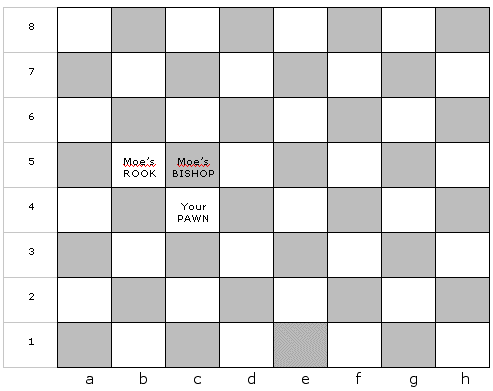
Let's say that it's your turn. Your pawn in square c4 can capture Moe's rook in b5, because it's diagonal from your pawn, only one box away. And just like all captures, you move your pawn to where the captured piece was. This is pretty much the only way for your pawn to get out of its pre-assigned file. But what about Moe's bishop in box c5? Can you capture that? NO. You can't capture Moe's bishop, because it's not at a diagonal. You can't move that pawn forward until the bishop gets out of the way. (By the way, for all of you that think this rules stuff is going too slow, there's a special move that pawns are allowed to make when they get to the fifth row. But don't worry about that until you get to the special moves section.)
3- When your pawn reaches the opposite end of the board, it gets a "promotion." This means that it can become any piece it wants to be, getting that piece's rules, powers, and dental plan. Here's a word of advice: promote your pawn into a queen. Sure, there might be times when the pros decide to not turn their pawns into queens (a strange action called "underpromoting"), but if you are reading this article, then you do not have to worry about such hibbledy-hobbledy. Just promote your pawn to a queen. What's the benefit? Well, now you have two queens on the board! (Or if you lost your queen earlier, you get it back). In fact, if you get every pawn to the opposite end of the board, you can have nine queens on the board at the same time (the original plus the eight pawns).


